Job Description
Becoming a floral designer involves more than just arranging flowers in a vase.
You also may have to talk to customers, manage a store, and plan events.
That depends on whether you decide to remain an employee, own your own business, or work as a manager in someone else’s shop.
Duties
- Acquire flower arrangement supplies.
- Respond to customer inquiries.
- Schedule consultations.
- Set up seasonal design displays.
- Book floral deliveries.
- Process retail transactions.
- Fulfill online orders (if any).
- Resolve issues with customers.
- Keep work areas clean and stocked.
- Connect with flower vendors.
- Handle supply shipments.
- Plan venue decoration schemes (ex: weddings or charity galas).
Salary
The average floral designer’s annual salary totals approximately $52,979 as recently as January 27, 2022.
Depending on your location, the amount you make per year could range from $43,008-$64,027.
If you can demonstrate your creativity and build up a history of positive customer relationships, you could earn a decent living right after graduating high school.
Your first position, however, might earn you below the average at about $20,000-$30,000 per year.
You will make even more money if you have spent time interning while in college for interior design or event planning.
Annually National Average Salary: $35,500
Average Annual Salary by State
| State | Avg. Annual Salary |
|---|---|
| Alabama | $30,660 |
| Alaska | $44,780 |
| Arizona | $34,740 |
| Arkansas | $30,360 |
| California | $42,790 |
| Colorado | $40,220 |
| Connecticut | $42,050 |
| Delaware | $33,640 |
| District of Columbia | $42,920 |
| Florida | $35,600 |
| Georgia | $33,020 |
| Hawaii | $40,260 |
| Idaho | $32,080 |
| Illinois | $35,920 |
| Indiana | $32,410 |
| Iowa | $29,180 |
| Kansas | $31,210 |
| Kentucky | $30,820 |
| Louisiana | $32,690 |
| Maine | $35,620 |
| Maryland | $37,870 |
| Massachusetts | $42,470 |
| Michigan | $34,270 |
| Minnesota | $35,020 |
| Mississippi | $29,030 |
| Missouri | $31,520 |
| Montana | $30,160 |
| Nebraska | $32,460 |
| Nevada | $38,930 |
| New Hampshire | $34,510 |
| New Jersey | $40,840 |
| New Mexico | $29,950 |
| New York | $41,240 |
| North Carolina | $35,900 |
| North Dakota | $33,210 |
| Ohio | $30,430 |
| Oklahoma | $26,790 |
| Oregon | $37,480 |
| Pennsylvania | $32,000 |
| Rhode Island | $37,450 |
| South Carolina | $34,340 |
| South Dakota | $32,160 |
| Tennessee | $32,090 |
| Texas | $32,670 |
| Utah | $31,360 |
| Vermont | $37,330 |
| Virginia | $35,120 |
| Washington | $39,190 |
| West Virginia | $27,090 |
| Wisconsin | $31,490 |
| Wyoming | $32,720 |
| Puerto Rico | $21,770 |
Annual Average Salary: Top 5 States
The top earning state in the field is Alaska, where the average salary is $44,780.
These are the top 5 earning states in the field:
Conducted by: Bureau of Labor Statistics, Department of Labor.
* Employment conditions in your area may vary.
How to Become: Step-by-Step Floral Designer Career Guide
Step 1Research Training Options
The America Institute of Floral Designers offers the best resources for seeking floral design training near you.
Seek help from your local chapter if you need to know the best course of action for becoming a certified floral arranger.
Additional relevant learning tracks include any programs related to crafts or visual arts.
If at least indirectly, even graphic arts or drawing classes could prepare you for floral arranging because these courses teach you how to work with different colors, styles, and textures.
The same is true of clothing fashion courses.
Step 2Register for Classes
First, find out what the prerequisites are for the courses you want to take, and enroll in those.
In some cases, you can test out of courses for which you already have a working knowledge, however.
Before you register, you may also want to talk to an admissions counselor or academic advisor who can set you on the right track.
If you plan to seek training from a private floral design school instead of at a university or community college, you will need to maybe speak to the instructors directly.
Otherwise, someone on the sales team may be able to guide you to the courses meant for you.
Step 3Build Your Portfolio
If you ever helped people decorate for their wedding, anniversary, and birthday parties or holidays and special occasions, you could draw from those experiences.
Some people may refer you to new jobs based on the work you have done for them in the past.
It is also wise to take pictures of arrangements you already made for people to save for when you decide to find more customers.
You can carry those image examples in physical collections you store in binders anywhere you go.
In addition, you can refer them to online websites or social media pages that showcase your best work.
No matter how you present your portfolio examples, it will demonstrate your abilities to future buyers or employers.
Step 4Seek Internship Opportunities
You might find local floral shops willing to pay you a training wage.
For instance, grocery stores might hire you full-time if you at least have some volunteer experience arranging flowers in vases or making bouquets and corsages.
If you cannot find a paid internship just yet, an unpaid one could turn into a paying one later.
Step 5Seek full-time Employment
Apply to open positions where you had your internship.
Otherwise, your floral design instructors could provide you leads to companies in your area that welcome new arrangers on their team.
You also may want to contact some local grocery stores and flower shops or continue your online job search and network with wedding planners, event coordinators, and more.
Step 6(Optional) Prepare to Run Your Own Business
If you want to run your own floral arrangement business, take some accounting or management courses.
It will teach you how to stay organized and provide the most efficient customer service possible.
In addition, take classes that will demonstrate how to delegate tasks and boost team morale.
Budgeting and planning courses will also help you run a smooth flower delivery operation.
Step 7Continue Developing Your Craft
Take a new class occasionally and learn new techniques.
Keep up with the latest flower arrangement trends and seek ideas from event venue websites.
Join social media groups and stay connected with your classmates if you can too.
Education
To become a successful florist, having a diverse portfolio of past completed projects will probably take you further than your education will.
However, formal certificate and degree training will broaden your perspective, especially when running your own business.
Consider one of the following college educational levels as you continue to pursue floral design as a career.
Certificate
This may only take you about a year.
Even if you already have flower arrangement experience, it can solidify your confidence as you deliver what you hope will please your customers.
Associate Degree
At this level, you will learn design techniques that you may not have known about when you first started arranging flowers.
It will also provide you with new ways to manage employees and projects that you could not have acquired without formal education.
Bachelor’s Degree
After about four years of university education, you will have extensive exposure to artistic expressions of all types.
This will prepare you for arranging flowers to suit all preferences and styles.
It also may give you the power to fulfill larger scale event projects and maybe even serve celebrities someday or teach your craft to others.
Master’s Degree
As an expert in your field, you also may decide to obtain a master’s degree in one or more artistic disciplines.
This prepares you further for your own growth and shapes the futures of other people considering a floral design career.
Video About The Career
Licensing & Certification
You do not need an official license to pursue floral design.
However, obtaining an official certification from an accredited school in your area or an online program can establish your credibility.
You can add a certificate copy to your portfolio website pages and include it in communication with clients looking for someone proficient in floral design.
You can obtain optional floral design certifications.
However, you may also want to focus on how to obtain the business licenses required in your location.
This will build trust between you and your clients if you become a self-employed floral designer, especially if planning corporate events, weddings, or other large-scale private occasions.
Average Training Program Duration: 0-6 Months
Popular Programs
Job Outlook
You might face stiff competition as a floral designer at least until 2029.
From 2020 to 2030, the need will drop 20 percent, and the number of job openings may decrease by 8500 within this decade.
This does not mean you will not find opportunities, however.
Keep networking with people and listen for opportunities to take over someone who plans to retire, transfer or change careers.
Florists also create opportunities by adding flower arrangements to a list of multiple decorating services they offer to people who have upcoming events.
In addition, they might perform this craft while also holding down another job until they build up enough clientele.
Employment Growth Projection: -20%
2020
2030
That's a higher than average projected growth of -8,500 jobs.
Floral Designer: Interest Over Time
Should You Become A Floral Designer?
Overall Satisfaction: High

You should become a floral designer if you know how to balance creative expression with customer needs.
It is also an excellent occupational fit for you if you do not mind high order volumes during busy seasons.
According to the Payscale website, floral designers seem to be “highly satisfied with their job.”
It gives them the chance to work with their hands and create.
A common disadvantage expressed in employee views is the low starting salary, but it does not require much experience unless you want to become a manager or owner.
Average Salary: Low

Average salaries range from $43,008-$64,027 within the first 4-6 years of becoming a florist depending on location.
Some cities might offer higher-paying positions, but it also might cost more to live there.
You might only earn about $20,000-$30,000 if starting right out of high school if you have had less than a year of training and still working toward a florist certificate.
Job Growth Outlook: Low

Even though the need for florists seems to be on a sharp decline, you can search for locations where employees say they must work long hours and feel overworked.
For instance, you might find opportunities in smaller cities such as Danville, Illinois, or in high-elevation and remote locations, such as Scottsbluff, Nevada.
Chances to work as a florist also occur in most major cities, but you also face more competition for those positions.
Education Duration: 0-6 Months

The average length of time training to become a florist is a few months or less.
However, you could take continuing education courses and acquire a management degree.
This may take you a minimum of two but up to three or four years.
You might need an Associate’s or Bachelor’s degree if you decide to run your own shop or become a manager for someone else’s.
Personal Skills Needed

- Project management – If you want to become a successful florist, make sure you know how to manage multiple tasks and delegate shop responsibilities.
- Event planning – Much of your earnings may come from decorating with flowers at events rather than making individual bouquets.
- Sales or operations management – If you have been in the industry long enough, you will become responsible for attracting new retail customers and need to know how to run a flower shop.
- Order inventory tracking – You must keep track of all the supplies used and how many pieces you made daily.
- Customer service skills – You have to know how to communicate with customers and find out what they need.
- Order app usage – Online ordering has normalized circa 2020. Make sure you know how to respond to app orders using electronic mobile devices.
- Organization – This includes knowing how to schedule orders without double-booking deliveries and having a place for all your supplies.
- Creativity – You must know how to arrange flowers in a way that most pleases a customer’s taste and understand how colors and styles work together in general.
- Able to take instruction – You will need to follow orders from your customers and supervisors. This may require filling orders according to a popular arrangement “template” and not deviating from that sometimes.
Frequently Asked Questions
Q. How long do you have to go to school to become a floral designer?
It may only take you a year or less to become a floral designer whether you have obtained a florist certificate yet or not.
If you want to pursue more than just an entry-level florist career, however, you will need more education.
For instance, you can obtain an accounting or business fundamentals associate’s degree in about two years.
Any training beyond on-the-job experience is optional.
However, the associate’s degree will give you advanced training to run a flower shop.
It also prepares you to become a supervisor over people in a home and garden department or grocery store that also makes flower arrangements.
If you want to own a store, you will learn advanced business administration principles if you attend a four-year school, and this could open you up to opportunities for expanding to multiple locations or seeking above-average management pay.
Q. How much money does a floral designer make a year?
Earnings may only total less than $24,000 per year for a person who just enters the workforce as a florist.
Within the first four years, a floral designer’s salary may increase beyond $30,000.
To make the average salary of more than $52,000 predicted in January 2022, you may have to work in the field for at least 5-10 years.
The availability of opportunities may influence how much you can make in a year designing flower arrangements.
You typically would earn more in large metro areas with a population of 100,000 or more.
On the other hand, it is also possible to take on overflow in townships with a few thousand people or less where they do not have enough workers to fill all the orders.
Q. What kind of education do you need to be a floral designer?
As of 2021, 91% of Indeed florist applicants found a job after they finished high school or earn their GED before becoming hired.
About 5% of persons employed have earned at least an associate’s degree.
Only 3% have earned a bachelor’s degree.
Because of the drop in need predicted at least until 2030, however, you may require more education than in the past if you want to become a florist.
However, you also may earn more with a college education than without it.
Q. Are floral designers in high demand?
Currently, the demand has dropped, and the job growth outlook for this career may plummet to about 20% below average by the end of 2029.
However, you might increase your chances of becoming hired in this field if you also have retail experience and like interacting with customers.
Perhaps find a job as a cashier in a grocery store to start and see what happens.
Q. What skills do you need to have to be a floral designer?
You must have an eye for detail and arrange the flowers, greens, or other elements in just the right way.
It also may require that you mimic a popular floral arrangement, and you must know how to communicate with customers and resolve problems.









